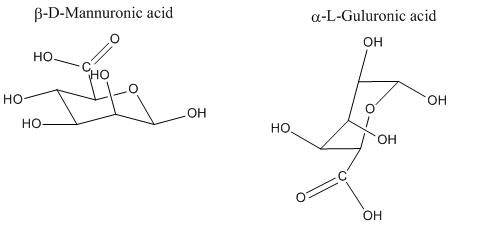User:David Griffin/Sandbox 1
From Proteopedia
| Line 3: | Line 3: | ||
One of the [[CBI Molecules]] being studied in the [http://www.umass.edu/cbi/ University of Massachusetts Amherst Chemistry-Biology Interface Program] at UMass Amherst and on display at the [http://www.molecularplayground.org/ Molecular Playground]. | One of the [[CBI Molecules]] being studied in the [http://www.umass.edu/cbi/ University of Massachusetts Amherst Chemistry-Biology Interface Program] at UMass Amherst and on display at the [http://www.molecularplayground.org/ Molecular Playground]. | ||
| - | Alginate is a linear, organic polymer isolated from bacteria and algae. It has been shown to be biocompatible (non-toxic to human cells) and has found numerous applications as a biomaterial for cellular engineering. Owing to its unique physical properties, alginate hydrogels have been used as a scaffold material for building artificial organs, as a dressing for ulcerous wounds and the targeted delivery of anti-cancer drugs. | + | Alginate is a linear, organic polymer isolated from bacteria and algae. It has been shown to be biocompatible (non-toxic to human cells) and has thus found numerous applications as a biomaterial for cellular engineering. Owing to its unique physical properties, alginate hydrogels have been used as a scaffold material for building artificial organs, as a dressing for ulcerous wounds and the targeted delivery of anti-cancer drugs. |
<applet size='[450,338]' frame='true' align='right' | <applet size='[450,338]' frame='true' align='right' | ||
Revision as of 17:56, 30 April 2010
One of the CBI Molecules being studied in the University of Massachusetts Amherst Chemistry-Biology Interface Program at UMass Amherst and on display at the Molecular Playground.
Alginate is a linear, organic polymer isolated from bacteria and algae. It has been shown to be biocompatible (non-toxic to human cells) and has thus found numerous applications as a biomaterial for cellular engineering. Owing to its unique physical properties, alginate hydrogels have been used as a scaffold material for building artificial organs, as a dressing for ulcerous wounds and the targeted delivery of anti-cancer drugs.
|
Alginate is composed of a random sequence of mannuronic acid (M) and guluronic acid (G). Exposure to divalent cations (e.g. calcium, magnesium, etc.) chemically cross-links alginate solutions forming a gel. Alginate can vary widely in length, monomeric sequence and G/M ratio depending on the source. The ratio of G/M in the chain influences the strength of alginate hydrogels and can be tuned by combining alginate obtained from different organisms. The spinning molecule to the right is an example of a short chain of sodium alginate.

